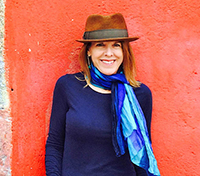12
Apr
Interview with Candice López
 How long have you been at SDCC? What is your mission there?
How long have you been at SDCC? What is your mission there?
For 25 years I’ve taught at San Diego City College, an inner city urban community college. As we have a stop on the San Diego trolley line, I have the great opportunity to work with diverse students from nearby Mexico as well as those from many fascinating countries, different age groups, gender and sexual orientations, abilities/disabilities, people of color and varying socio/economic groups. I lead the graphic design program and many of our students transfer on partial or full scholarship to some of the strongest design programs in the country. We are determined to make an impact on the graphic design field by bringing more diverse people into the design profession who will make a difference with their lives and work.
Do you have any personal stories about that time, when the Urban Art Trail was a dream in your heart?
When we bought an old warehouse in and edgy part of town we spent the first few years fixing the 1930’s car garage into a live/work studio. We then realized the need to change what was happening when you opened the front door. To make real change it is important to empower others to be part of it . Rafael developed a mural style that worked like a giant paint by numbers so children and untrained artists could be directly involved in art making. The grass roots nature of our movement drew good people to us for support, often they were strangers. One time we were painting a mural that required a scissor lift and we had run out of money to buy supplies and get the project done. A passerby chatted with us and returned from the ATM with an envelope full of cash! We were able to complete the Joy of Urban Living Mural and had seed money for the next mural.
How did your experience as a designer benefited the project?
I know photoshop and designers love to organize things as it makes us feel that all is right with the world. Perhaps that is why we love grids. Making a project of this scale required lots of hoop-jumping with city officials, property owners and supporting businesses. I was able to take art that Rafael created, photograph actual buildings and show people how it would look when we were finished. A picture is worth a thousand words they say and this was an effective tool to get approvals.
Were there women as well as men involved in the project?
Women were absolutely integral to the Urban Art Trail. One of the leaders Kim Paulson was an engineer at Hewlett Packard and brought along lots of volunteers who created colorful mosaics around trees. Women were up on scissor lifts helping us paint murals and electrical boxes and led the planting of flowers in tree rings. We even painted a mural called The Strength of the Women to celebrate that spirit with women and children from local shelters.
Do you think that art can be therapeutic?
Neighborhood art can break down barriers, engage and bring diverse people together. When people get involved in designing, creating and taking care of spaces they develop an interest in maintaining them and improve the overall quality of life there decreasing blight and crime. Like a chain reaction, it attracts new residents and business owners of like mind, promoting interaction in the public space. Art and design can help people express themselves, tap into their emotions, manage addictions and improve self-esteem.

